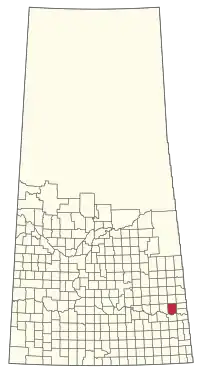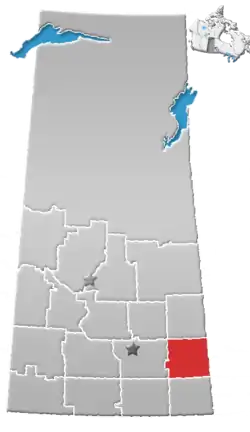Rural Municipality of Fertile Belt No. 183
The Rural Municipality of Fertile Belt No. 183 (2016 population: 781) is a rural municipality (RM) in the Canadian province of Saskatchewan within Census Division No. 5 and SARM Division No. 1.
Fertile Belt No. 183 | |
|---|---|
| Rural Municipality of Fertile Belt No. 183 | |
 Location of the RM of Fertile Belt No. 183 in Saskatchewan | |
| Coordinates: 50.618°N 102.232°W | |
| Country | Canada |
| Province | Saskatchewan |
| Census division | 5 |
| SARM division | 1 |
| Formed[1] | January 1, 1913 |
| Government | |
| • Reeve | Arlynn Kurtz |
| • Governing body | RM of Fertile Belt No. 183 Council |
| • Administrator | Lorie Jackson |
| • Office location | Stockholm |
| Area (2016)[3] | |
| • Land | 1,006.67 km2 (388.68 sq mi) |
| Population (2016)[3] | |
| • Total | 781 |
| • Density | 0.8/km2 (2/sq mi) |
| Time zone | CST |
| • Summer (DST) | CST |
| Area code(s) | 306 and 639 |
History
The RM of Fertile Belt No. 183 incorporated as a rural municipality on January 1, 1913.[1]
- Historical properties
There are two historical properties located within the RM.
- Our Lady of Assumption (Kaposvar) Roman Catholic Church - (also called Kaposvar Museum) Located in Esterhazy, the building was erected in 1906-1907 by Brothers of Father Jules Pirot with Hungarian farmers hauling stones from the surrounding area.[4]
- New Stockholm Lutheran Church - (also called Swedish Evangelical Lutheran New Strockholm Church) the building was erected in 1917 by Swedish immigrants. The church is located in the village of Stockholm.[5]
Geography
Communities and localities
The following urban municipalities are surrounded by the RM.
The following unincorporated communities are within the RM.
- Organized hamlets[6]
- Localities
Demographics
In the 2016 Census of Population conducted by Statistics Canada, the RM of Fertile Belt No. 183 recorded a population of 781 living in 334 of its 377 total private dwellings, a -0.5% change from its 2011 population of 785. With a land area of 1,006.67 km2 (388.68 sq mi), it had a population density of 0.8/km2 (2.0/sq mi) in 2016.[3]
In the 2011 Census of Population, the RM of Fertile Belt No. 183 recorded a population of 785, a 1.8% change from its 2006 population of 771. With a land area of 1,006.68 km2 (388.68 sq mi), it had a population density of 0.8/km2 (2.0/sq mi) in 2011.[9]
Government
The RM of Fertile Belt No. 183 is governed by an elected municipal council and an appointed administrator that meets on the second Tuesday of every month.[2] The reeve of the RM is Arlynn Kurtz while its administrator is Lorie Jackson.[2] The RM's office is located in Stockholm.[2]
Transportation
The Esterhazy Airport is located within the rural municipality.
References
- "Rural Municipality Incorporations (Alphabetical)". Saskatchewan Ministry of Municipal Affairs. Archived from the original on April 21, 2011. Retrieved May 9, 2020.
- "Municipality Details: RM of Fertile Belt No. 183". Government of Saskatchewan. Retrieved May 21, 2020.
- "Population and dwelling counts, for Canada, provinces and territories, and census subdivisions (municipalities), 2016 and 2011 censuses – 100% data (Saskatchewan)". Statistics Canada. February 8, 2017. Retrieved May 1, 2020.
- Our Lady of Assumption (Kaposvar) Roman Catholic Church Archived 2012-10-19 at the Wayback Machine
- New Stockholm Lutheran Church Archived 2014-03-23 at the Wayback Machine
- "2019-2020 Rural Revenue Sharing Organized Hamlet Grant". Government of Saskatchewan. Retrieved May 4, 2020.
- "Saskatchewan Census Population" (PDF). Saskatchewan Bureau of Statistics. Archived from the original (PDF) on September 24, 2015. Retrieved May 9, 2020.
- "Saskatchewan Census Population". Saskatchewan Bureau of Statistics. Retrieved May 9, 2020.
- "Population and dwelling counts, for Canada, provinces and territories, and census subdivisions (municipalities), 2011 and 2006 censuses (Saskatchewan)". Statistics Canada. June 3, 2019. Retrieved May 1, 2020.
